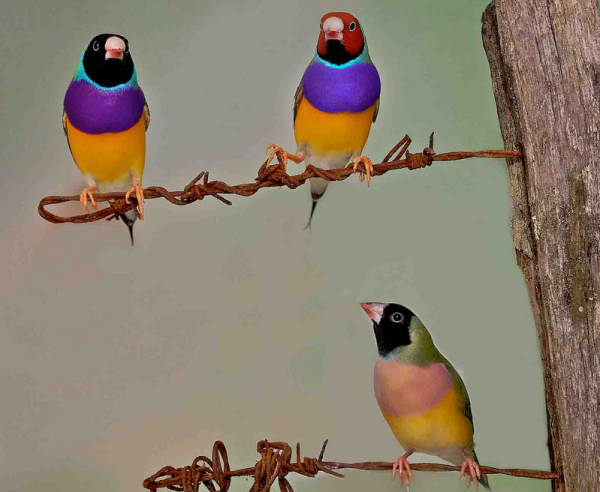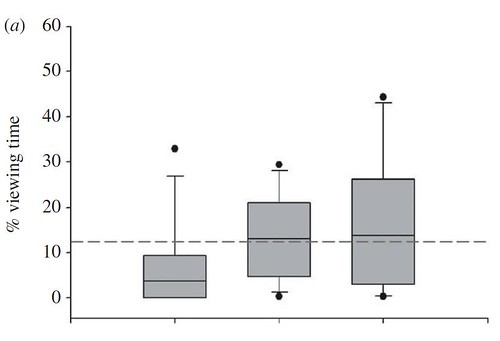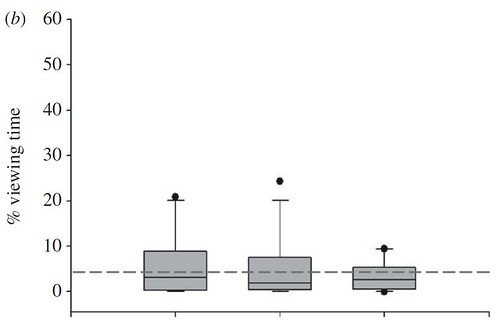Journal Club: One-eyed wooing

SUMMARY: A newly published study shows that beauty is in the right eye of the beholder for birds, providing the first demonstration in any animal of visual lateralization of mate choice.
 Conservation biologists are well aware that the most challenging part of their job is to convince their animals to breed — it’s certainly not as simple as putting two individuals of the opposite sex into an enclosure. In the case of highly visual animals, like birds, appearance of their potential mate is very important. Further, birds also have their own opinions as to who makes a suitable mate. But how do birds perceive potential mates during courtship?
Conservation biologists are well aware that the most challenging part of their job is to convince their animals to breed — it’s certainly not as simple as putting two individuals of the opposite sex into an enclosure. In the case of highly visual animals, like birds, appearance of their potential mate is very important. Further, birds also have their own opinions as to who makes a suitable mate. But how do birds perceive potential mates during courtship?
As many ornithologists or keen-eyed birdwatchers can tell you, avian courtship displays often consist of a series of sideways dance moves rather than a full-frontal approach. Given this, you probably won’t be surprised to learn that many bird species also prefer to view a potential mate with one eye rather than the other. For example, there is some evidence to suggest that male zebra finches, Taeniopygia guttata, prefer to look at females with their right eye during courtship [doi:10.1016/S0003-3472(86)80235-4].
But this right eye preference is more than a quirky behaviour. Molecular studies in courting zebra finches have identified an asymmetric gene expression pattern in the male zebra finch’s brain. The genes in one region are activated whilst gene expression in the corresponding region on the opposite side of his brain remain quiescent. Known as immediate early genes because their expression is activated transiently and rapidly in response to a specific stimulus — courtship, in this case — these genes are expressed at a higher level in the left hemisphere of the male zebra finch’s brain, which receives visual input from the bird’s right eye. But even more interesting is that birds lack the corpus callosum, that brain regions that facilitates communication between the two brain hemispheres in placental mammals, suggesting that short-term mate choice may be confined to the left brain hemisphere in birds (“lateralisation”).
To investigate this phenomenon, Jennifer Templeton and James Mountjoy, both Associate Professors of Biology at Knox College in Galesburg Illinois, collaborated with behavioural ecologist Sarah Pryke, who was a postdoc at the time at Macquarie University in Sydney, Australia, and Simon Griffith, an Associate Professor of Biology at Macquarie. They designed several studies to identify whether lateralisation could be seen in the endangered Gouldian finch, Erythrura gouldiae, a polymorphic songbird.
Gouldian finches have three distinct colour polymorphisms or “morphs”: the plumage on their heads is either red, black or (very rarely) yellow. Both males and females show strong preferences for a mate with head colouring that matches their own. This preference is highly adaptive since mixed parentage chicks suffer high pre-hatching mortality due to genetic incompatibilities (read more here).
The team designed a series of non-invasive experiments using four stimulus chambers, three of which housed “stimulus birds” and the fourth of which remained empty (control). For three days, each stimulus bird was included in a trial consisting of three sexually-naive adult birds, a black male and two females — one red, one black, none of which had seen each other before. The male test finch wore a tiny temporary eyepatch made of cotton that prevented him from seeing out of the occluded eye.
First, the team established whether there was a difference in how long a test black male looked at a stimulus bird depending upon which eye he used (figure 1):



Figure 1. (a–c) Box plots of the per cent total trial time that black males (n = 12) in each eye condition closely viewed social stimuli from adjacent choice zones. Horizontal dashed line denotes overall mean. (a) Black female, (b) red female and (c) black male.
.. .. .. .. .. .. .. .. .. .. ..
But looking is one thing, and courting is another — how was the male’s courtship affected? During their studies, the team found that eight of the twelve black males sang to at least one female during at least one of their three trials, but they never sang to males. So the team examined whether courtship singing was affected by which eye the test male used to look at the stimulus females (figure 2):


Figure 2. (a, b) Box plots of the per cent total singing time that black males (n = 12) in each eye condition sang to both female morphs. Horizontal dashed line denotes overall mean. (a) Black female, (b) red female.
.. .. .. .. .. .. .. .. .. .. ..
These findings provide compelling evidence that the ability to distinguish a particular morph is constrained to a bird’s right-eye/left-brain hemisphere.
“Our findings raise all sorts of interesting questions about how visual information mediates the behavior of Gouldian finches”, explained Professor Templeton in email. This is particularly important for Gouldian finches since choosing the wrong mate can have dire fitness consequences for these birds. Already, Professor Templeton is planning more experiments to add detail to these findings.
“In addition to testing the other head colors and females, we’re hoping to see how the visual information mediates hormonal responses,” writes Professor Templeton. She goes on to explain that by doing this, she hopes to “get a better handle on the neurohormonal mechanisms that influence female Gouldian [finch]s’ abilities to manipulate the sex ratio of their offspring when they mate with a male of the wrong head color.”
These data also provide intriguing insights into behaviours seen in other bird species. For example, lateralisation could be the reason so many avian courtship rituals include sideways dance displays and may also explain why, when a male views females with a particular eye during courtship, he is stimulated to produce an enhanced courtship display.
But birds are the one surviving lineage of modern dinosaurs, which may tempt some people to overlook the applicability of these findings to mammals. But these studies provide support for the recent hypothesis that the left brain hemisphere in many animal taxa is specialized to distinguish between conspecifics and heterospecifics (doi:10.3819/ccbr.2012.70006).
“In people, Helen Fisher and her colleagues have actually shown that ‘romantic love’ may be lateralized as well (in domaine-rich areas of the brain such as the right ventral tegmentum).” explains Professor Templeton. Further, “dopamine-rich areas of the brain such as the right ventral tegmentum are important for addiction studies (addicted to love?).”
But Fisher’s studies used individuals who had already made a mate choice, notes Professor Templeton, “whereas we used sexually naive birds who were given a choice of potential mates to view — kind of like going to a bar.”
Sources:
Jennifer J. Templeton, D. James Mountjoy, Sarah R. Pryke, & Simon C. Griffith (2012). In the eye of the beholder: visual mate choice lateralization in a polymorphic songbird. Biology Letters doi:10.1098/rsbl.2012.0830
Jennifer Templeton; emails: 28, 29 & 30 September and 3 & 9 October 2012.
L. Workman, & R.J. Andrew (1986). Asymmetries of eye use in birds. Animal Behaviour, 34 (5), 1582-1584 doi:10.1016/S0003-3472(86)80235-4
Orsola Rosa Salva, Lucia Regolin, Elena Mascalzoni, & Giorgio Vallortigara (2012). Cerebral and behavioural asymmetries in animal social recognition. Comparative Cognition & Behavior Reviews, 7, 110-138 doi:10.3819/ccbr.2012.70006
Many thanks also to my twitter pals for sending requested PDFs, especially Ivan Oransky, Tom Houslay, Steven Byrnes and Tommy Leung.
Read more about the amazing breeding system of Gouldian finches:
Mate Choice: when Mr Right isn’t good enough
Plumage color influences choice of mates and sex of chicks in Gouldian Finches, Erythrura gouldiae
NOTE: this piece is reformatted slightly from the original, which was published on The Guardian.
.. .. .. .. .. .. .. .. .. .. ..
Follow Grrlscientist’s work on facebook, Google +, LinkedIn, Pinterest and of course, twitter: @GrrlScientist
email: grrlscientist@gmail.com
Top photo: A trio of Gouldian finches, Erythrura gouldiae. Black-headed male (L), red-headed male (R), black-headed female (lower).
Image: Sarah Pryke (This image has been cropped).
